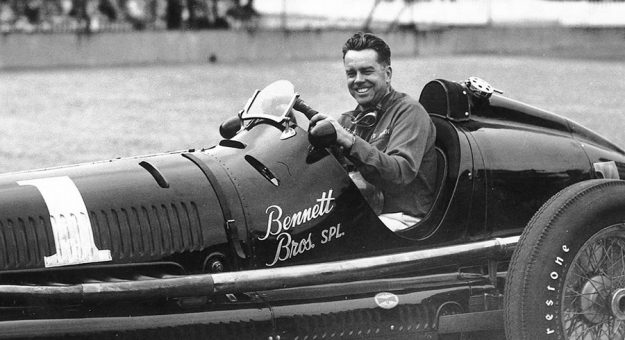Ted Horn was one of the most naturally talented race car drivers this country has produced.
He won the AAA National Championship three consecutive years, 1946-’48. With his famed sprint car nicknamed “Baby,” he earned three AAA Sprint Car titles, along with multiple feature wins. Twenty-four in 1948 alone. He set 88 AAA track records, and he established a record at Indianapolis Motor Speedway that remains intact today — nine consecutive 500s with a top-four finish.
Horn’s initiation to the sport was most unusual.
Born in Cincinnati, Ohio, he’d moved several times with his family before they put down roots in Los Angeles. In 1926, the 16-year-old was on his way to work at the Los Angeles Times when a traffic cop pulled him over.
Running late, Horn had his $15 Model T jalopy rattling and banging at well past the speed limit. For whatever reason, the officer took a liking to the kid with the toothy grin and didn’t ticket him. Instead, he made a deal.
“I tell you what,” he told Horn. “Go to San Jose Sunday, there’s a track there. They always have more cars than drivers. Get one, and when you get all the speed out of your system, come back to the station house for your car. That’s where it’ll be.”
Motivated to retrieve his transportation, Horn dutifully made his way to San Jose Speedway, but the only car available wouldn’t run. The next week was a repeat.
However, Noel Bullock, noting the kid’s determination, told him he could drive his car the following Sunday at Banning Speedway. Bullock’s Rajo ran, but Horn didn’t for long. He tangled with another driver and flipped out of the track.
His obligation fulfilled; Horn retrieved his car from the police. Still, despite his poor performance, he derived an unexpected thrill from his brief stint in a race car. He was hooked.
For the next two years, Horn chased race cars throughout California. He raced jalopies, stock cars and outlaw big cars until a break came — a ride at Legion Ascot Speedway.
Drivers such as Wilbur Shaw, Floyd Roberts and Bill Cummings raced weekly for large purses at the popular five-eighths-mile oval. Horn didn’t experience immediate success, but he persevered and clawed his way to the top of the action.
His reputation established on the West Coast, in 1934 Horn moved east to compete in the rich Midwest and East Coast AAA races, including Indianapolis. He made Paterson, New Jersey’s Gasoline Alley his headquarters and operated from there for the remainder of his career.
The first year a car owner offered him a shot at Indianapolis. After a few laps in the car, Horn decided it wasn’t speedy enough to make the show and passed on the opportunity.
He made the 1935 500 driving one of the 10 Ford team cars, headed by 1925 Indianapolis winner Pete DePaolo. The Miller-built cars’ design had an Achilles’ heel, however. The steering boxe was mounted too close to the hot exhaust manifold, which cooked the grease, seizing the steering gears. Horn’s failed after 145 laps.
Incredibly, that was his only DNF at Indianapolis. Beginning in 1936, Horn completed every lap but one in nine consecutive 500s — 1,799 of a possible 1,800 and racked up a second-place finish, four thirds and four fourths in the process.
Still, Horn never won the 500. The 1947 race provides no better example of not only the speedway’s callous fickleness, but Horn’s extraordinary ability.
Horn won the pole in the former Wilbur Shaw Maserati, but come the race he immediately encountered trouble. Forced into two early stops to repair a major oil leak, by lap 16, he was already a seemingly insurmountable seven laps behind.
But Horn charged through the field, turning laps six mph faster than the leaders. He was sixth at the halfway point and third, behind only Mauri Rose and Bill Holland, at the checkered flag.
Surely, a 500 victory awaited him. But it wasn’t to be. With a third championship secured, Ted Horn perished at the DuQuoin State Fairgrounds on Oct. 10, 1948.
